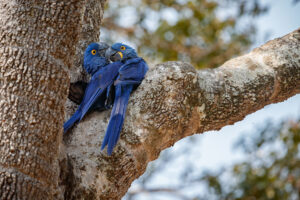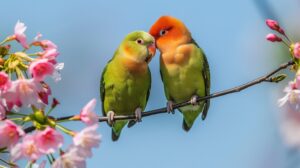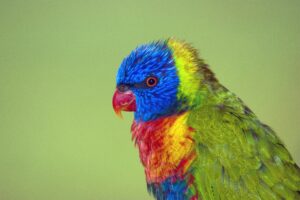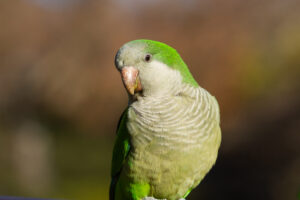Introduction
The majestic Salmon Cockatoo, with its striking salmon-pink plumage and charismatic personality, has captivated bird enthusiasts across the United States for decades. Also known as the Moluccan Cockatoo or Rose-breasted Cockatoo, this magnificent parrot species stands out among avian companions for its beauty, intelligence, and affectionate nature. If you’re considering adding a feathered friend to your family, the Salmon Cockatoo deserves a spot at the top of your list.
Native to the Moluccan Islands of Indonesia, the Salmon Cockatoo (Cacatua moluccensis) is one of the largest and most visually stunning cockatoo species. With their distinctive salmon-pink feathers, impressive crest, and deep, soulful eyes, these birds make an immediate impression on anyone fortunate enough to encounter them. However, their appeal extends far beyond their exotic appearance.
In this comprehensive guide, we’ll explore five compelling reasons why the Salmon Cockatoo has earned its reputation as a premier companion bird for dedicated avian enthusiasts. We’ll delve into their remarkable personalities, care requirements, dietary needs, and the unique joys and challenges of Salmon Cockatoo ownership. Whether you’re a seasoned bird keeper or considering your first avian companion, this article will provide valuable insights into what makes the Salmon Cockatoo such a special addition to the right household.
It’s important to note that while the Salmon Cockatoo offers incomparable companionship, these intelligent creatures also require significant commitment in terms of time, resources, and emotional investment. As we celebrate their many wonderful qualities, we’ll also address the responsibilities that come with providing a forever home for these magnificent birds, ensuring you have a complete picture before making this important decision.

Reason #1: Unmatched Beauty and Presence
The Salmon Cockatoo’s visual appeal is often what first attracts potential owners, and it’s easy to understand why. These stunning birds possess a unique color palette that sets them apart from other parrot species. Their predominantly white plumage is enhanced by a beautiful salmon-pink hue that suffuses their crest, chest, and underwings, creating a soft, elegant appearance that can brighten any room.
Standing approximately 20 inches tall with a wingspan of about 14 inches, the Salmon Cockatoo makes an impressive visual statement. Their most distinctive feature is undoubtedly their spectacular retractable crest, which fans open in a dramatic display when the bird is excited, curious, or alarmed. This expressive feature gives the Salmon Cockatoo an additional dimension of communication that many bird owners find fascinating.
The Salmon Cockatoo’s physical presence extends beyond their coloration. They possess a graceful carriage and movement that many describe as regal. Their deeply expressive dark brown eyes seem almost human in their ability to convey emotion and engagement. According to the National Aviary, the Salmon Cockatoo is considered one of the most physically striking of all parrot species.
The beauty of the Salmon Cockatoo is enhanced by their immaculate grooming habits when properly cared for. These birds take pride in their appearance, spending significant time each day preening their feathers to maintain their pristine condition. A healthy, well-cared-for Salmon Cockatoo possesses a luster and vibrancy that can’t be captured in photographs—their presence must be experienced in person to be fully appreciated.
Their visual impact isn’t limited to passive observation. The Salmon Cockatoo often engages in “display behaviors” that showcase their full splendor, including crest-raising, wing-spreading, and even “dancing” movements that emphasize their colorful accents. These natural behaviors make the Salmon Cockatoo not just a pet but a living work of art that brings dynamic beauty into your home environment.
As noted in our guide to exotic birds, the Salmon Cockatoo’s appearance alone can transform a living space, creating a focal point of natural beauty and inspiring conversations with visitors who are invariably captivated by these magnificent creatures.
Reason #2: Extraordinary Intelligence and Trainability

The Salmon Cockatoo possesses remarkable cognitive abilities that rival those of many mammals. These birds are considered among the most intelligent of all parrot species, demonstrating problem-solving skills, tool use, and an impressive capacity for learning that continues to astonish researchers and owners alike.
Studies conducted by avian cognition experts have placed cockatoos among the intellectual elite of the bird world. The Salmon Cockatoo specifically demonstrates exceptional spatial reasoning, memory, and creative thinking. Dr. Irene Pepperberg, renowned for her work with African Grey parrots, has noted that large cockatoos like the Salmon Cockatoo show comparable cognitive development to that of a 3-5 year old human child in certain tasks.
This intelligence makes the Salmon Cockatoo highly trainable. They can learn an extensive vocabulary of words and phrases, though they’re typically not as prolific speakers as some other parrot species. What they lack in vocabulary, they make up for in their understanding of concepts and their ability to use vocalizations appropriately in context. Many Salmon Cockatoo owners report that their birds seem to understand far more language than they can produce.
Beyond speech, the Salmon Cockatoo can master a wide range of tricks and behaviors with consistent positive reinforcement training. From the basic “step-up” command to more complex routines involving multiple steps, these birds excel at learning new skills. They can be taught to wave, turn around, retrieve objects, and even solve simple puzzles designed for their enrichment.
The Salmon Cockatoo’s trainability extends to practical matters as well. They can learn household routines, recognize different family members, and even adapt their behavior based on situational cues. With proper guidance, a Salmon Cockatoo can become surprisingly well-mannered and integrated into family life.
According to the World Parrot Trust, the Salmon Cockatoo’s intelligence comes with responsibility: “These birds require consistent mental stimulation to prevent boredom and the behavioral issues that can result.” This means that training shouldn’t be viewed simply as teaching tricks, but as an essential component of providing proper mental exercise for your Salmon Cockatoo.
Our article on avian enrichment activities offers additional insights into keeping intelligent birds mentally stimulated. For the Salmon Cockatoo, this intellectual engagement isn’t optional—it’s a fundamental requirement for their psychological well-being and a deeply rewarding aspect of the human-bird relationship.
Reason #3: Deep Emotional Bonds and Affectionate Nature

Perhaps the most compelling reason many bird enthusiasts are drawn to the Salmon Cockatoo is their remarkable capacity for emotional connection. These birds are renowned for forming intense, lasting bonds with their human companions that many owners describe as unlike any other pet relationship they’ve experienced.
The Salmon Cockatoo is considered one of the most affectionate parrot species, often seeking physical contact and emotional reassurance from their preferred humans. They frequently request cuddles, head scratches, and attention in ways that can feel surprisingly similar to the affection-seeking behaviors of more traditional pets like dogs.
This emotional depth is reflected in research conducted by avian behavior specialists. Studies have shown that cockatoos possess highly developed limbic systems—the brain structures associated with emotion processing. The Salmon Cockatoo demonstrates clear emotional responses including joy, attachment, jealousy, and even grief, indicating a rich inner emotional life.
The bonding capacity of the Salmon Cockatoo manifests in numerous touching behaviors. These birds often engage in “preening” their human companions—a behavior normally reserved for trusted flock mates in the wild. Many Salmon Cockatoo owners report that their birds recognize their footsteps or the sound of their car arriving home, responding with enthusiastic greetings and displays of excitement.
Dr. Susan Friedman, a leading authority on parrot behavior, notes that the Salmon Cockatoo’s social needs stem from their natural history: “In the wild, these birds live in close-knit flocks with complex social structures. In captivity, human caregivers become their flock, and they seek the same depth of connection they would naturally form with other cockatoos.”
This desire for connection means the Salmon Cockatoo thrives on quality time with their human family. They enjoy participating in household activities, whether perched on your shoulder during daily tasks or simply being in the same room where they can maintain visual contact. Many Salmon Cockatoo owners incorporate their birds into family rituals like meals, movie nights, or morning routines.
As highlighted in our guide to companion bird relationships, the bond with a Salmon Cockatoo requires nurturing and consistency but rewards owners with a level of emotional connection many never expected to experience with an avian companion.
It’s worth noting that this intense bonding nature means the Salmon Cockatoo isn’t well-suited to homes where they would receive minimal interaction. These birds form attachments equivalent to those between human family members and can experience significant distress if separated from their bonded companions or if they receive insufficient attention.
Reason #4: Impressive Lifespan for Lifelong Companionship

When considering adding any pet to your family, lifespan is an important factor—and the Salmon Cockatoo offers the potential for truly lifelong companionship. With proper care, these remarkable birds can live 60-80 years in captivity, making them not just a pet but a lifelong companion who may even outlive their owners.
The Salmon Cockatoo’s extraordinary longevity means that bringing one into your home is more akin to adopting a family member than acquiring a traditional pet. Many Salmon Cockatoo owners develop estate plans that include provisions for their birds, ensuring their feathered companions will receive proper care throughout their natural lifespan.
According to the Association of Avian Veterinarians, the Salmon Cockatoo has one of the longest potential lifespans among commonly kept parrot species. This longevity is both a blessing and a responsibility. As noted by Dr. Brian Speer, a leading avian veterinarian, “The decision to adopt a Salmon Cockatoo should be made with the understanding that you’re committing to providing quality care for potentially many decades.”
The extended lifespan of the Salmon Cockatoo offers unique rewards. These birds continue to develop emotionally and intellectually throughout their lives, with many owners reporting that their relationship with their cockatoo deepens and evolves over the years. The Salmon Cockatoo’s capacity for ongoing learning means they can continue to master new skills and adapt to changing household circumstances even as they age.
This longevity also means that the Salmon Cockatoo can become a constant through major life transitions. There are numerous heartwarming stories of these birds providing emotional support and continuity through their owners’ moves, career changes, relationships, and other significant life events. For many Salmon Cockatoo enthusiasts, their bird represents a stable, loving presence through decades of life changes.
The flip side of this impressive lifespan is the serious commitment it requires. Potential Salmon Cockatoo owners should honestly assess their ability to provide appropriate care, stimulation, and affection not just for years, but potentially for decades. Our article on long-term pet planning offers valuable guidance for those considering a commitment to a long-lived species like the Salmon Cockatoo.
For those who are prepared for this level of commitment, the Salmon Cockatoo’s longevity offers the rare and precious opportunity to develop a truly lifelong bond with a highly intelligent, emotionally responsive companion.
Reason #5: Conservation Value and Education Opportunity

Beyond the personal rewards of Salmon Cockatoo companionship, there’s a broader significance to keeping these magnificent birds that appeals to many conscientious bird lovers. The Salmon Cockatoo is listed as Vulnerable on the International Union for Conservation of Nature (IUCN) Red List, with wild populations declining due to habitat loss and illegal poaching for the pet trade.
Responsible Salmon Cockatoo ownership, focusing on birds bred in captivity by reputable breeders, helps reduce demand for wild-caught specimens that threaten natural populations. By supporting ethical breeding practices and providing excellent care for captive birds, Salmon Cockatoo enthusiasts contribute to preservation efforts for this vulnerable species.
Many Salmon Cockatoo owners become passionate advocates for conservation, using their birds as ambassadors to educate others about the challenges facing wild parrot populations. According to the World Parrot Trust, “Well-cared-for companion birds can serve as powerful representatives of their wild counterparts, inspiring conservation action and awareness.”
The Salmon Cockatoo’s striking appearance and engaging personality make them particularly effective education ambassadors. People who might otherwise have little interest in wildlife conservation often become captivated when meeting a Salmon Cockatoo in person, creating openings for meaningful conversations about habitat protection and responsible pet ownership.
Some dedicated Salmon Cockatoo owners participate in community education programs, bringing their well-socialized birds to schools, nature centers, or community events to teach others about parrot behavior, needs, and conservation status. These outreach activities not only benefit conservation awareness but also provide valuable socialization and mental stimulation for the birds themselves.
For families with children, a Salmon Cockatoo can be an unparalleled opportunity to teach responsibility, empathy, and respect for wildlife. Children who grow up with these intelligent birds often develop a deeper appreciation for animal intelligence and the importance of species preservation. As noted in our guide to introducing children to pets, the relationship between a child and a Salmon Cockatoo can foster compassion and environmental consciousness that lasts a lifetime.
Even for those who never participate in formal education programs, sharing your life with a Salmon Cockatoo inevitably means becoming an informal ambassador for these birds, as visitors to your home encounter—often for the first time—the remarkable intelligence and personality these creatures possess.
Essential Care Requirements for Salmon Cockatoos
While the Salmon Cockatoo offers extraordinary rewards as a companion, proper care is essential for their health and happiness. Understanding their specific needs is crucial before bringing one of these magnificent birds into your home.
Housing and Environment
The Salmon Cockatoo requires spacious housing that accommodates their large size and active nature. Minimum cage dimensions should be 36″ W × 24″ D × 48″ H, though larger is always better. The cage should be constructed of durable materials, as these powerful birds can destroy flimsy cages with their strong beaks.
Beyond the cage, Salmon Cockatoo care must include safe out-of-cage time daily. These social birds need at least 3-4 hours outside their cage for exercise, exploration, and interaction. A dedicated bird-safe room or play area with appropriate perches, toys, and climbing opportunities is ideal for these active periods.
Temperature control is another important aspect of Salmon Cockatoo care. These birds do best in environments maintained between 65-85°F (18-29°C) with moderate humidity (50-60%). Exposure to extreme temperatures or dry conditions can compromise their respiratory health and feather condition.
Nutrition and Diet
A balanced diet is fundamental to Salmon Cockatoo care and longevity. According to avian nutrition experts, these birds thrive on a diet consisting of:
- High-quality pelleted food (50-60% of diet)
- Fresh vegetables and fruits (30-40% of diet)
- Nuts, seeds, and healthy grains (10-15% of diet)
- Occasional healthy protein sources like cooked egg or small amounts of cooked chicken
The Salmon Cockatoo’s diet should never consist primarily of seeds, as this leads to nutritional deficiencies and health problems. Foods to avoid include chocolate, avocado, caffeine, alcohol, and foods high in salt, sugar, or fat.
Fresh, clean water should always be available, and food bowls should be cleaned daily. Many Salmon Cockatoo owners find that foraging toys that require the bird to work for food pieces not only provide entertainment but also mental stimulation that mimics natural behaviors.
Our detailed guide to parrot nutrition provides additional specific recommendations for maintaining optimal Salmon Cockatoo health through proper diet.
Health Monitoring and Veterinary Care
Regular veterinary care is essential for Salmon Cockatoo health. These birds should have annual check-ups with an avian veterinarian—a specialist with specific training in bird health, as standard veterinarians often have limited experience with exotic birds like the Salmon Cockatoo.
Common health concerns for the Salmon Cockatoo include:
- Psittacine Beak and Feather Disease (PBFD)
- Psittacosis (a bacterial infection)
- Aspergillosis (a fungal infection)
- Fatty liver disease (often diet-related)
- Feather plucking (usually psychological in origin)
Early detection is crucial for successful treatment of these conditions. Salmon Cockatoo owners should monitor their birds for signs of illness including changes in droppings, appetite, energy level, or behavior. Any significant changes warrant prompt veterinary attention.
Preventive care includes regular weighing (weight loss is often the first sign of illness in birds), proper grooming including nail and wing trims when necessary, and maintaining proper environmental cleanliness to prevent bacterial or fungal growth.
Mental Stimulation and Enrichment
Perhaps the most overlooked aspect of Salmon-Cockatoo care is the critical importance of mental stimulation. These highly intelligent birds require substantial environmental enrichment to prevent boredom and the destructive or self-harming behaviors that can result from insufficient stimulation.
Effective Salmon-Cockatoo enrichment includes:
- Rotating selection of appropriate toys (puzzle toys, foraging toys, shreddable items)
- Regular training sessions using positive reinforcement techniques
- Varied social interactions with family members
- Environmental changes and novel experiences (supervised outdoor time in a secure harness, exposure to new objects or environments)
- Opportunities for natural behaviors like climbing, chewing, and foraging
According to the Association of Avian Veterinarians, many behavioral problems in the Salmon-Cockatoo can be prevented through proper enrichment and mental stimulation. Our comprehensive enrichment ideas for parrots provides numerous specific activities suited to the Salmon-Cockatoo’s intelligence level.
Challenges of Salmon-Cockatoo Ownership
While we’ve explored the many wonderful qualities that make the Salmon-Cockatoo a desirable companion, responsible consideration must also include an honest assessment of the challenges these birds present.
Noise Level
The Salmon-Cockatoo is among the loudest of all parrot species. Their vocalizations can reach over 135 decibels—comparable to a jet engine or rock concert. While they don’t vocalize constantly, their morning and evening calls are particularly loud and can be problematic in apartments, condominiums, or closely situated homes.
This noise level is a natural behavior that cannot be eliminated through training, though it can sometimes be managed and reduced through proper enrichment and consistent handling. Potential Salmon Cockatoo owners must realistically evaluate whether their living situation can accommodate these noise levels.
Destructive Potential
The Salmon-Cockatoo’s powerful beak is designed to crack hard nuts and reshape wood in the wild. In a home environment, this translates to remarkable destructive capability. Without proper outlets for their chewing instincts, a Salmon-Cockatoo can damage furniture, moldings, doorframes, and potentially dangerous items like electrical cords.
Providing appropriate chewing toys and materials is essential, as is careful supervision during out-of-cage time. Despite these precautions, Salmon-Cockatoo owners should expect some level of household damage as a normal part of living with these birds.
Time Commitment
The social and emotional needs of the Salmon Cockatoo translate to a substantial time commitment. These birds require several hours of direct interaction daily, plus time for care tasks like cage cleaning, food preparation, and environmental enrichment.
This time investment cannot be significantly reduced even after the initial training period. The Salmon Cockatoo is a poor choice for individuals with extensive travel requirements or very demanding work schedules unless additional caretakers are consistently available.
Emotional Intensity
The same emotional depth that makes the Salmon Cockatoo such a rewarding companion can create challenges. These birds can develop problematic behaviors if their emotional needs aren’t met, including:
- Excessive screaming for attention
- Feather plucking or self-mutilation
- Aggressive behaviors toward perceived rivals for their bonded person’s attention
- Separation anxiety when apart from preferred humans
Managing these potential issues requires consistent boundaries, appropriate socialization with multiple family members, and sometimes professional behavioral consultation. As noted by avian behaviorist Pamela Clark, “The Salmon Cockatoo’s emotional needs are substantial and non-negotiable—they cannot be trained out of needing significant interaction and engagement.”
Finding and Selecting a Salmon Cockatoo
If you’ve considered the responsibilities and rewards and determined that a Salmon Cockatoo is right for your household, finding a healthy, well-socialized bird from an ethical source is the crucial next step.
Adoption vs. Purchase
Given the Salmon Cockatoo’s long lifespan and the challenges some owners face in maintaining these birds for decades, adoption from reputable rescue organizations should be your first consideration. Organizations like the Avian Welfare Coalition and BirdBrain Rescue specialize in cockatoo rehabilitation and adoption.
Adoption offers several advantages:
- Many rescue Salmon Cockatoos are already adults with established personalities
- Rescue organizations can often provide detailed information about the bird’s preferences and behaviors
- Adoption fees are typically lower than purchase prices from breeders
- Adoption provides a home for a bird in need rather than creating demand for additional breeding
If adoption isn’t possible in your area, purchasing from a reputable breeder is the next best option. Responsible breeders of Salmon Cockatoos will:
- Allow you to visit their facility and see how birds are housed and socialized
- Provide health records and genetic background information
- Ask you detailed questions about your experience and housing situation
- Offer ongoing support and guidance after purchase
- Maintain clean, appropriate housing for their birds
Avoid purchasing Salmon Cockatoos from pet stores or bird marts, as these birds often come from mass-breeding facilities with poor socialization and potential health issues.
What to Look For
When selecting a specific Salmon Cockatoo, pay attention to:
Physical indicators of health:
- Clear, bright eyes without discharge
- Clean nostrils and beak
- Smooth, well-maintained feathers without bald patches
- Active, alert demeanor
- Clean vent area
- Appropriate weight (not visibly thin or obese)
Behavioral indicators:
- Responds with interest to interaction
- Shows curiosity about environment
- No signs of stereotypic behaviors (rocking, pacing, etc.)
- Eats and drinks normally
- Makes normal vocalizations
As detailed in our guide to selecting healthy birds, a veterinary check-up should be scheduled immediately after acquiring any new bird, including the Salmon Cockatoo, regardless of the source.
Conclusion: Is a Salmon Cockatoo Right for You?
The Salmon Cockatoo represents one of the most rewarding—and challenging—companion birds available to experienced avian enthusiasts. Their stunning beauty, remarkable intelligence, emotional depth, impressive lifespan, and conservation value make them extraordinary companions for the right household.
However, these same qualities create substantial responsibilities. The Salmon Cockatoo requires a level of commitment comparable to adding a human family member, with needs for attention, stimulation, and care that will span decades. Their potential for noise, destruction, and emotional complexity means they’re best suited to experienced bird owners with appropriate physical space, financial resources, and lifestyle flexibility.
For those who can meet these needs, the Salmon Cockatoo offers incomparable companionship. The bond formed with these magnificent birds often becomes a defining relationship in their owners’ lives—a connection characterized by mutual trust, communication, and affection that transcends typical pet relationships.
As you consider whether a Salmon Cockatoo might be right for your family, take time to:
- Visit rescues or breeders to interact with these birds in person
- Connect with current Salmon Cockatoo owners through clubs or online forums
- Research the specific legal requirements for exotic bird ownership in your location
- Consult with an avian veterinarian about health care needs and costs
- Honestly assess your ability to provide appropriate housing, diet, veterinary care, and attention for potentially 60+ years
Whatever you decide, approaching the possibility of Salmon Cockatoo ownership with thorough research and realistic expectations is the first step toward a successful human-bird relationship.
For more information about bird care, behavior, and selection, explore our comprehensive resources at petspump.com, where you’ll find detailed guides on exotic bird housing requirements, parrot behavior understanding, and long-term care planning for birds.
Resources for Salmon Cockatoo Owners and Enthusiasts
- Association of Avian Veterinarians – Find qualified avian veterinarians
- World Parrot Trust – Conservation information and care resources
- Bird Tricks – Training techniques and enrichment ideas
- Avian Avenue – Community forum for cockatoo owners
- Lafeber Company – Research-based nutrition information
By approaching Salmon Cockatoo ownership with the seriousness it deserves and the enthusiasm these remarkable birds inspire, you set the foundation for one of the most extraordinary human-animal bonds possible in companion animal relationships.






